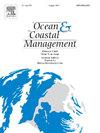Spatiotemporal prediction of offshore wind fields based on a hybrid deep learning model for maritime navigation
IF 5.4
2区 环境科学与生态学
Q1 OCEANOGRAPHY
引用次数: 0
Abstract
Accurate wind speed prediction is crucial for offshore wind power generation, ship navigation, and the use of renewable energy, as it optimises energy production, enhance maritime safety. This study introduces GswinLSTM, a novel hyrid model that integrates Long Short-Term Memory (LSTM) neural networks with the Group Swin Transformer (Gswin Transformer) to address the limitations of existing prediction models and improve wind speed prediction accuracy. Compared to conventional approaches, GswinLSTM simultaneously captures temporal dependencies and spatial correlations in wind speed data, significantly improving forecasting accuracy and robustness. The model is validated using ERA5 reanalysis data, which accurately represents offshore climate conditions. Experimental results demonstrate that GswinLSTM outperforms state-of-the-art models, including Transformer, Residual U-Net (ResUnet), and Convolutional LSTM (ConvLSTM), across four evaluation metrics, particularly in long-term forecasting where conventional methods struggle with error accumulation. By effectively capturing spatiotemporal dependencies, GswinLSTM enhances both prediction stability and precision in extended forecasting horizons. With strong theoretical contributions and practical applicability, this model offers valuable insights for wind field operations, maritime navigation, and climate monitoring. The findings underscore GswinLSTM's potential to drive advancements in renewable energy forecasting and environmental risk assessment, making it a promising tool for future atmospheric and meteorological studies. Additionally, the model's strong predictive capability supports maritime navigation safety, offshore wind energy optimization, and provides actionable insights for coastal management policies, such as maritime spatial planning and carbon reduction strategies.
基于混合深度学习模型的海上风场时空预测
准确的风速预测对于海上风力发电、船舶航行和可再生能源的使用至关重要,因为它可以优化能源生产,提高海上安全。为了解决现有预测模型的局限性,提高风速预测精度,本研究引入了一种将长短期记忆(LSTM)神经网络与群风速变压器(Gswin Transformer)相结合的新型混合模型GswinLSTM。与传统方法相比,GswinLSTM同时捕获了风速数据的时间依赖性和空间相关性,显著提高了预测精度和鲁棒性。利用ERA5再分析数据对模型进行了验证,该模型准确地反映了近海气候条件。实验结果表明,GswinLSTM在四个评估指标上优于最先进的模型,包括Transformer、Residual U-Net (ResUnet)和卷积LSTM (ConvLSTM),特别是在传统方法与误差积累作斗争的长期预测中。通过有效捕获时空相关性,GswinLSTM在扩展的预测视野中提高了预测的稳定性和精度。该模型具有很强的理论贡献和实际适用性,为风场作业、海上航行和气候监测提供了有价值的见解。这些发现强调了GswinLSTM在推动可再生能源预测和环境风险评估方面的潜力,使其成为未来大气和气象研究的一个有前途的工具。此外,该模型强大的预测能力支持海上航行安全、海上风能优化,并为沿海管理政策(如海洋空间规划和碳减排战略)提供可操作的见解。
本文章由计算机程序翻译,如有差异,请以英文原文为准。
求助全文
约1分钟内获得全文
求助全文
来源期刊

Ocean & Coastal Management
环境科学-海洋学
CiteScore
8.50
自引率
15.20%
发文量
321
审稿时长
60 days
期刊介绍:
Ocean & Coastal Management is the leading international journal dedicated to the study of all aspects of ocean and coastal management from the global to local levels.
We publish rigorously peer-reviewed manuscripts from all disciplines, and inter-/trans-disciplinary and co-designed research, but all submissions must make clear the relevance to management and/or governance issues relevant to the sustainable development and conservation of oceans and coasts.
Comparative studies (from sub-national to trans-national cases, and other management / policy arenas) are encouraged, as are studies that critically assess current management practices and governance approaches. Submissions involving robust analysis, development of theory, and improvement of management practice are especially welcome.
 求助内容:
求助内容: 应助结果提醒方式:
应助结果提醒方式:


